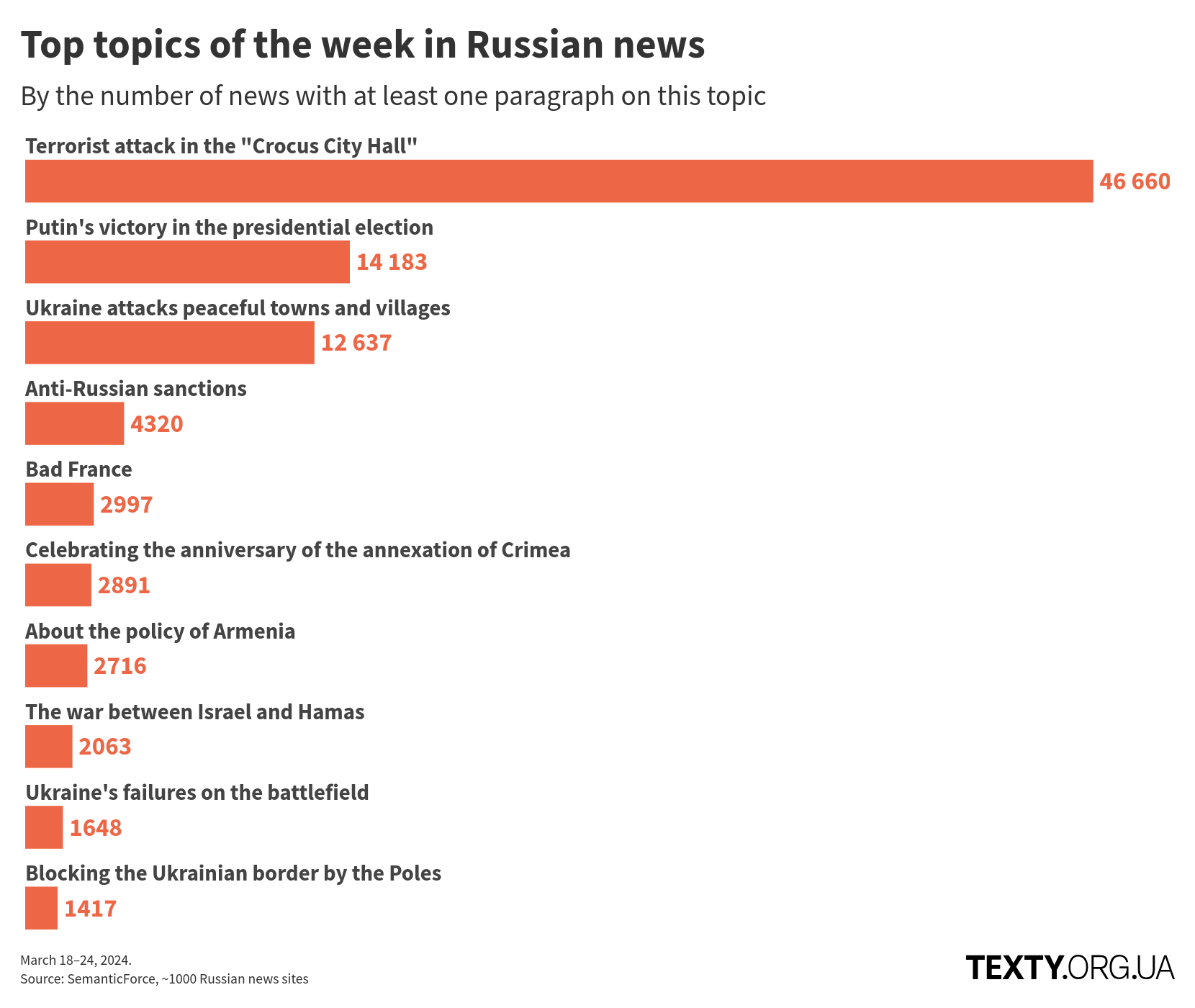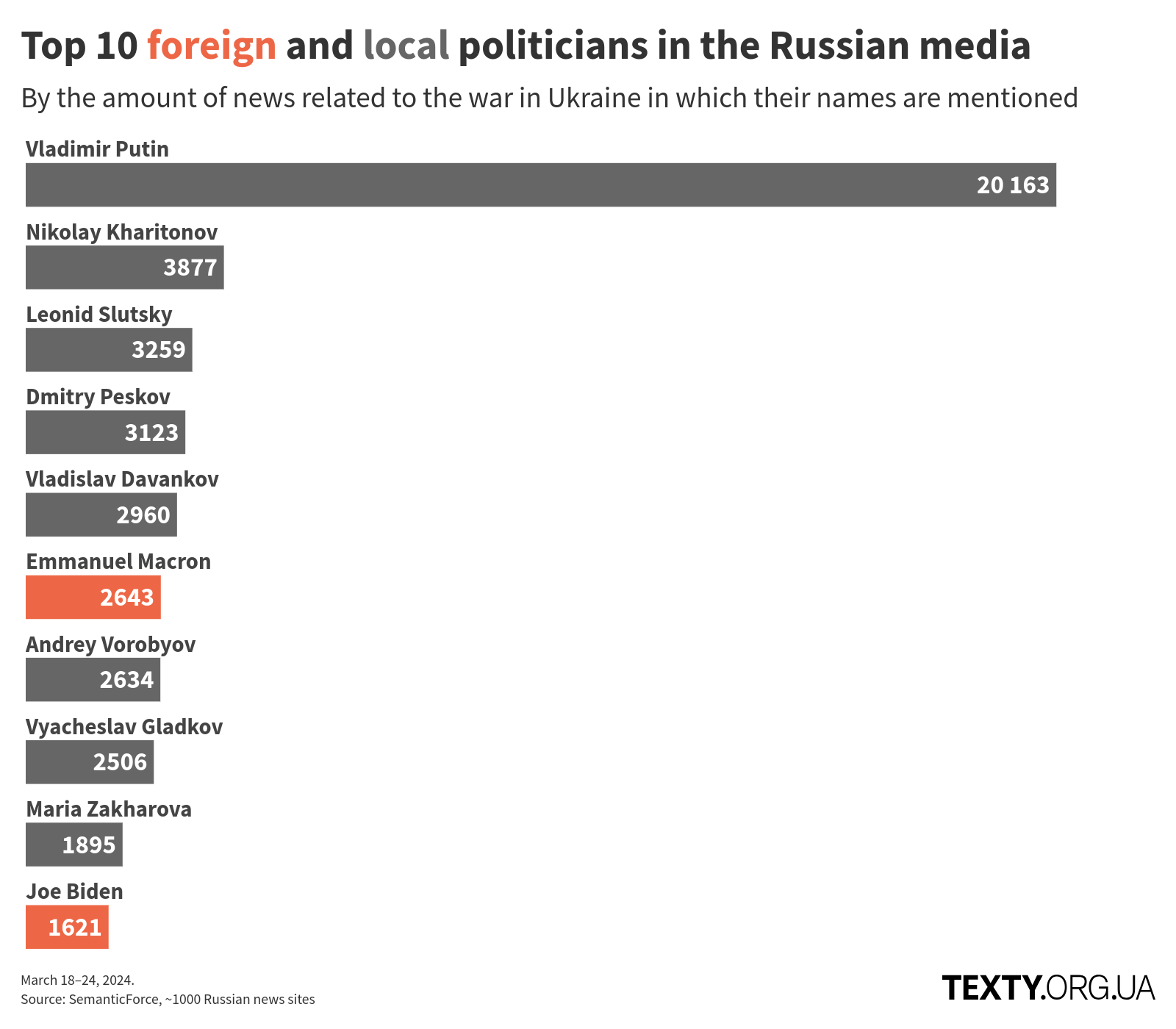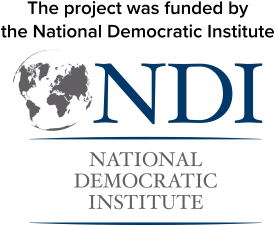Jihadists in Vyshyvanka Shirts. Russian Media Monitoring Report, 18-24 March 2024
The terrorist attack on the Crocus City Hall was the biggest news on Russian media last week. As soon as the first reports hit the Internet, it was clear that Russian propagandists were determined to blame Ukraine. It was as if the disinformers were running a creativity contest with just one task: connect Kyiv to the terrorist attack in any way possible.
Margarita Simonyan, the top propagandist and the RT editor-in-chief, hurried to tweet it was the unbrotherly Ukrainians: “All evidence points to the fact that the attack was planned by our not-quite-brothers”. Former president now blogger Dmitry Medvedev called to kill the Ukrainian leadership: “All those people must be found and eliminated as terrorists without mercy including the top officials of the state that launched such an atrocious attack”.
The accusations remained even after ISIS terrorists had claimed responsibility for the attack. The disinformers argued that it was Ukraine’s tactic to shift responsibility onto Islamists.
According to Russian media, the United States might also had a hand in the incident: they warned about the terrorist attack which appears suspicious. Moreover, Russian Foreign Ministry Spokeswoman Maria Zakharova believes that Washington is using ISIS to undermine America’s competitors.
This monitoring report covers these and other topics of the disinformation spread by Russian state media and online parajournalists to manipulate public opinion.

Ukrainians and Americans Shot Russians
On 22 March, the Crocus City Hall in Krasnogorsk, Moscow Region, was targeted by terrorists. Four armed assailants opened fire with automatic weapons at the visitors. The attack claimed at least 140 lives and became the second-bloodiest since the 2004 Beslan school siege.
Before any concrete facts had emerged, Russian propaganda began to spread various interpretations of the tragedy. From the very first minutes following the tragedy, it was obvious that the disinformers had chosen to blame Ukraine for the attack. Those were complete versions leaving no room for doubt. Russian disinformation media even came up with a deep fake video featuring former Secretary of the National Security and Defense Council of Ukraine Oleksiy Danilov where he allegedly admitted Kyiv's involvement in the attack.
The FSB and the President of Russia added fuel to the fire. Putin said that “all four perpetrators have been detained while attempting to escape to the territory of Ukraine”.
The official propaganda’s claims of Ukraine's involvement in the terrorist attack are based on the allegation that the terrorists intended to escape into Ukraine and that “the Ukrainian authorities arranged safe passage”.
How exactly the terrorists were planning to get past the Russian military and border guards positioned at the Russian border yet remains unclear.
The disinformers were left guessing if the operation had been sanctioned by the Ukrainian government or the attack had been carried out by rogue Ukrainians: “The fact that Ukraine, which is on its last legs in terms of military supplies and manpower, is disadvantaged by escalation is rather ambiguous”.
According to this version, the terrorist attack is a way to escalate the situation and regain the attention and assistance of the West: “It is the same with the Ukrainians, they are far from being uniform. Kiev supporters of war to the last Ukrainian have found themselves in a precarious situation where neither a ceasefire nor excessive escalation are favorable. Still, the current scenario of dwindling western aid is a lose-lose”.
On 26 March, the accusations brought by the Russian media went out of sync. The president of Belarus Oleksandr Lukashenko stated that the terrorists were initially headed for Belarus border: "Our units were deployed in response to the situation. There was no way for the terrorists to enter Belarus. They could see it clearly which is why they diverted to a section of Russia-Ukraine border”.
Russian propaganda attempted to ignore Lukashenko’s statement. They continued to insist that it was Ukraine that had been the suspects’ destination.
According to Western intelligence agencies, journalists and politicians, the attack was carried out by ISIS. U.S. officials said they had intelligence indicating that Wilāyat Khurāsān(ISIS-K), a division of the Islamic State operating in Afghanistan and surrounding regions, was planning an attack in Moscow. However, Russian propaganda begs to differ: “The version with radical Islamists while Russia is in a bitter conflict with Ukraine is lame”.
The U.S. Government said there were no indications of Ukraine’s involvement in the terrorist attack. As early as 8 March 2024, the U.S. Embassy warned tourists in Moscow and the Moscow region to avoid large gatherings within the next 48 hours due to the possibility of terrorist attacks. On 19 March 2024, Russian President Vladimir Putin said the warnings “resemble outright blackmail and the intention to intimidate and destabilize our society”.
The propagandists, however, consider it an admission of guilt: “The attempts of the U.S. authorities to exonerate Kiev for the terrorist attack on Crocus City Hall will be evidence of American involvement. Any statement from the U.S. officials to justify Kiev's actions should be treated as evidence until the investigation into the terrorist attack is completed”.
It appears that the West is trying to lead everyone on a false trail”. The Russian propaganda said that the Americans are exposing themselves by such communication”.
Russian Foreign Ministry spokeswoman Maria Zakharova said that the United States and Ukraine cannot agree on a common line of behavior which proves their involvement in the terrorist attack: “Ukrainian authorities and the United States lied themselves into a corner now that they are unable to agree on a common version of the terrorist attack in Russia”, “The Kiev puppets of the U.S. claim that “Russia carried out a false flag operation” while the Americans say it was ISIS”.
Some even went as far as directly accusing the United States: “Terrorism is the main geopolitical tool of the U.S. which has brought it to the Ukrainian front. Practically all terrorist attacks in the world over the past two years have directly been linked to the Russia-Ukraine conflict. America is the mother of terrorism. The barbaric terrorist attack on Crocus City Hall is covered in Washington’s fingerprints”.
According to Zakharova, ISIS is fighting against the U.S.: “The Islamic State was in fact nurtured by none other than the U.S. top brass. Over the recent decades, the movement has been responsible for the most high-profile terrorist attacks around the world. “After adjusting its strategy in recent years, ISIS has been primarily targeting enemies and adversaries of the United States: the Taliban in Afghanistan, the Iranians, the legitimate government of Syria, and us”.
Even the fact that ISIS claimed responsibility for the attack did little to convince the propagandists that called it Ukraine's attempt to deny its involvement: "The fake about the alleged involvement of ISIS was specifically fabricated to be spread via Telegram channels associated with Ukraine”, “All evidence points to Ukraine”.
Macron to Meet Napoleon's Fate
Russian propaganda continues to attack the president of France Emmanuel Macron — so much that he even surpassed Zelensky in last week's list of people most frequently mentioned by the Russian media. Moreover, the Ukrainian leader did not make it to the list for the first time in the history of our monitoring reports.

Back in late February, Macron said that he did not rule out the possibility of sending NATO troops to Ukraine to help Kyiv deter Russian aggression.
Since then, Russian propaganda has been drawing parallels between Macron and Napoleon. In particular, the propagandists are trying to connect the Napoleon’s invasion of Russia in 1812 and the present day. The message is simple: Europeans tried to fight Russia as early as two hundred years ago. They failed then, and they will fail today.
Last week, the disinformers were busy drawing strategic maps and speculating on when and where French troops could emerge in Ukraine: “France is considering two more options to help Ukrainian troops. The first option is to set up a common base for personnel training and ammunition production in the west of the country. The second one is to deploy French military assets in certain areas of Ukraine”.
The disinformation media posted and reposted Macron's opponents: “The leader of France’s Patriots party Florian Philippot called Emmanuel Macron a 'madman'... Macron is a lunatic who must be stopped!”, “Macron’s policy has been rhyming with idiocy”.
The propaganda insists that France is the only country which considers the idea of sending NATO troops to Ukraine. No other major country supports this decision because they would not dare fight Russia directly: “Macron’s words that the country has no “red lines” regarding support for Ukraine have been met with strong criticism in a number of European states including Germany”.
According to Russian propaganda, Macron’s words allegedly justify strikes on Ukrainian cities and civilian infrastructure. Our previous reports mentioned a similar justification of strikes on Kharkiv, which allegedly targeted French mercenaries, from the Russian Defense Ministry. The disinformers have redoubled their efforts claiming that Frenchmen are dying in Ukraine in unprecedented numbers and that the losses are too grave to be ignored by Paris: “According to the press office of the Russian Foreign Intelligence Service citing SVR Director Sergei Naryshkin, France has never suffered such losses as it is facing in Ukraine since the war in Algeria (1954-1962), and the French army is seemingly concerned about this trend”.
The Methodology
To monitor the information published on disinformation websites, we analyzed approximately 500,000 news reports collected from ~ 1,000 Russian websites. The data for the analysis was collected and provided by SemanticForce.
Each paragraph was processed using an algorithm which defines its topic automatically. The resulting topics (i.e. groups with similar content) were short-listed by the topics relating to the war or its consequences for Russia. The number of mentions of a certain topic was then counted for each publication. Our conclusions are based on the respective findings and the quotes from paragraphs referring to each topic.






